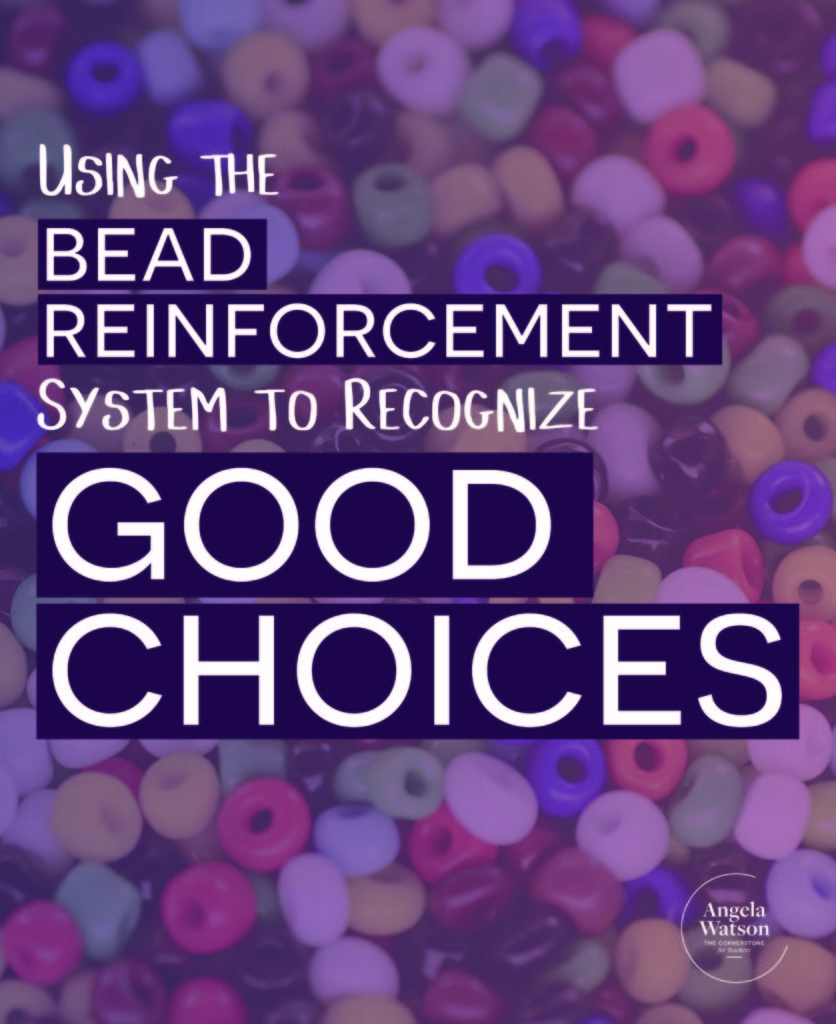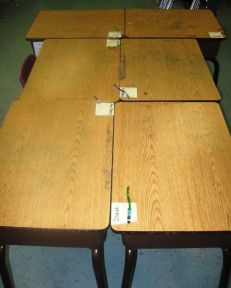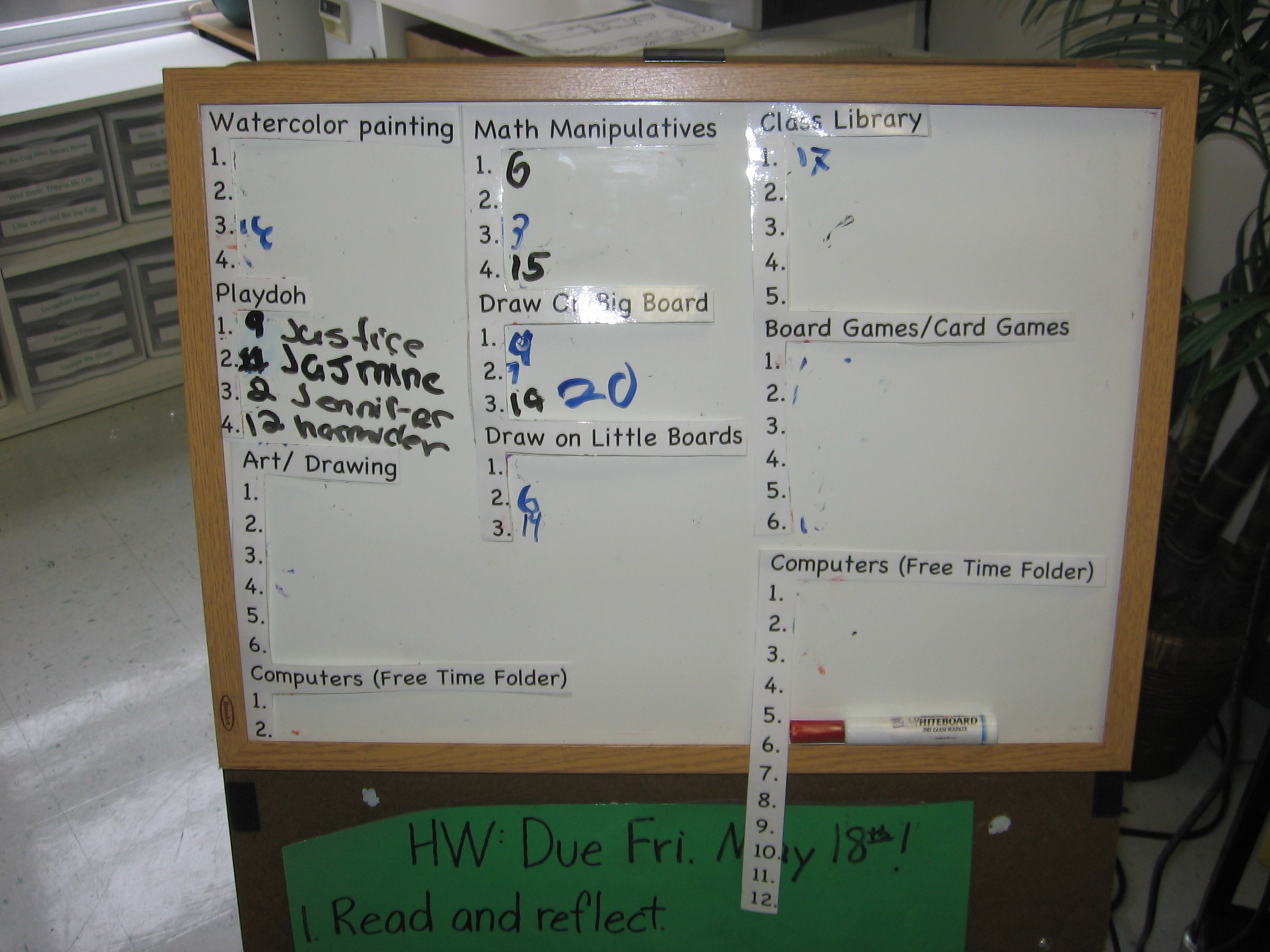A former co-worker of mine came up with the idea to use beads instead of the more traditional beans or marbles to keep track of students’ positive behavioral choices, and when I tried out the idea for myself, I realized the possibilities for adaptation were almost limitless. I experimented with the format for awhile and tailored it to meet the needs of my class, and ended up with the system outlined here. The photo shows what might be the most ridiculous-looking pipe cleaner you’ve ever seen, but trust me, this system is simple, fun, and the kids LOVE it! This page has been adapted from The Cornerstone book.



The basic principle of the bead system
Primary grade students often struggle with monitoring their behavior according to abstract concepts like showing respect and being cooperative. Beads can serve as a concrete tool to recognize their good decision making. Students can earn beads for demonstrating any on-task, appropriate behaviors that the teacher wants to reinforce. A privilege is earned at the end of the week for children who have earned a pre-determined number of beads.
What you need
- half a pipe cleaner for each child
- a small bag of identical beads (I use plastic tri-beadsthat fit together)
How to start the system with your class
1)Explain the basic principle of the system to students. Have them suggest positive classroom behaviors that could earn beads (following directions, completing work on time, etc.) and list them on a chart for the children’s reference. (The brainstorming process was explained in more detail in ‘The World’s Easiest Token System’ section of the book and on the token system page; the process can be used with any reinforcement method you use.)
2)At the bottom of the chart, write the reward for earning the set number of beads each week and explain it to the class. 10 is usually a good number if you want all your kids to be successful. (Remember, this isn’t a behavior management system: the idea is to support students in making good choices and provide a positive reinforcement, so the vast majority if not all of your students should be able to reach the required numbers of beads each week.) Possible rewards could be participation in Fun Friday or free time. One year I let my kids participate in centers such as play-dough, watercolor paints, math manipulatives, and board games. This was the ONLY time they got to do those things in third grade so it was a HUGE privilege.
3)Show students how you have taped one end of a pipe cleaner to each child’s desk or chair. Tell the children that they are each responsible for their own pipe cleaner and beads. Discuss what will happen if beads are lost or stolen. Frame the conversation around the importance of honesty and responsibility.
4)End the discussion by giving specific verbal reinforcement and a bead to each child in the class. Complimenting each student on something they’ve done well that day allows children to see firsthand how the system works, and helps them experience success and ‘buy into’ the concept right away.
What to do at the end of the week
At 1:00 pm every Friday (or the last day of the school week), I ask students to turn in their beads, starting with the child who has the most. I’ll ask if anyone has 20 beads, then 19, and so on. The children bring them up to me in their open palms for me to ‘check’ (you know which children’s beads actually need to be counted) and then they put them back into my bead box. After a child has returned the beads, he can sign up for a center on the wipe-off board chart. This way, the kids who earned the most beads get to pick first. (My kids can sign up using their name or their number, which is why you see names and numbers on the board.) The children who did not earn the specified number of beads are to work silently and independently on an assignment of their choice.
Frequently-asked questions
What type of things should I give beads for?
ANY behaviors you want to reinforce can earn beads. Besides the obvious good behaviors, I give beads from time to time for: wearing the school uniform, being on time for school, walking quietly in the hall, getting a compliment from another teacher, lining up quickly after recess, and cleaning up materials when first asked (those who keep working or play around quickly learn that when you say time’s up, you mean it). I often give beads to kids for using time wisely, staying on-task, and completing a pre-determined amount of work in a set amount of time. For example, I’ll tell the kids they have 15 minutes to complete an activity and after that amount of time, I walk around and give out beads to those who have done so, making accommodations for individual kids as needed.
Do kids get beads individually or do you give them to the whole class?
Both. Sometimes only a few kids earn them, and sometimes I’ll compliment the whole class for a job well done and give them to everyone.
What do you say and do when you give beads out?
Sometimes when kids are working, I’ll walk around quietly and slip beads onto their desks and whisper encouragement. Other times, I make a huge deal and reward them in front of the class. Having the teacher smile at and compliment them is a greater reward than the bead itself for most kids. Often, I’ll give beads to everyone when the class is doing a good job and give two beads to those who needed no reminders to stay on-task or did an exceptional job. Once in awhile when the majority of the class is talking too much and there’s a handful of kids really working diligently, I’ll say, “Wow, thanks, Joe and Dara. You two are determined to get this assignment done even when there’s noise and distractions all around you. Come up and get a bead.” The most important thing is to GIVE VERBAL REINFORCEMENTS along with the beads. The kids need to know exactly what they did right so that they’ll do it again. There should be no mystery surrounding how beads are earned.
Should I combine the bead system with The World’s Easiest Token System?
I wouldn’t recommend it. They serve the same purpose so using both systems simultaneously is redundant. I developed the token system first and used that for a few years, tried a year with no reward system, and then started using the bead system. I’ve explained both on my website so that teachers can choose what works best for them and their students.
Are the beads a behavior management tool?
No–they don’t address or manage negative behaviors at all. The beads simply reinforce positive behavioral choices. I developed the bead system to give young students a concrete representation of the good choices they’d made. Sometimes verbal reinforcements are not enough to support kids in overcoming challenging self-discipline issues. Complimenting students and handing them a bead–a tangible reminder that they’d done well–has a profound impact on most kids. They count up their beads repeatedly throughout the week and proudly show them off to each other. The beads are also a great tool to help the teacher focus on the positive things students do instead of only pointing out what they’ve done wrong. For students who needed a behavior management system to address excessive disruptive behavior, you can develop an individual behavior plan.

Angela Watson
Founder and Writer
Sign up to get new Truth for Teachers articles in your inbox
Discussion
OR

Join our
community
of educators
If you are a teacher who is interested in contributing to the Truth for Teachers website, please click here for more information.

















is it angela watson who develop bead and token system?
Yes, I did!
This sounds great. What do you recommend if students are taking others beads?
Also, what system would you recommend for 4-6th grades? The token system?
Thank you!
I used this system before. The few times a child took someone else’s beads deliberately, they lost all their beads. Harsh, but it worked.